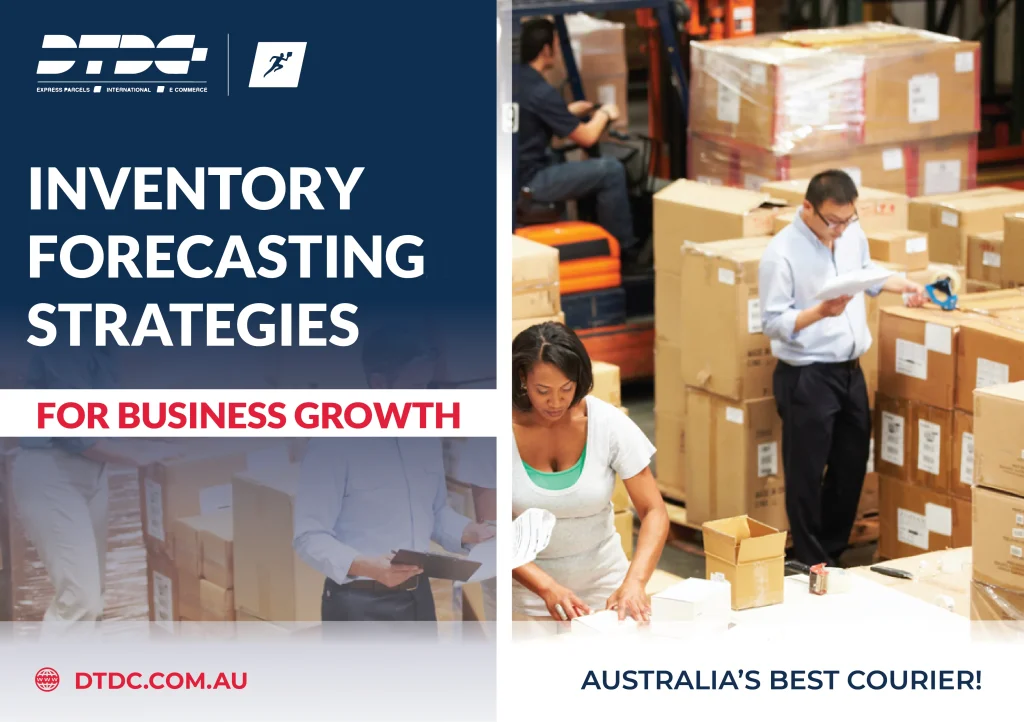Introduction
When your business starts spreading all over and expands to the global markets, then it’s finally reaching the height it deserves. The more your business expands, the greater are the opportunities you get, but don’t forget that it also brings up on complex challenges too. Inventory forecasting is significant for a business for both customer satisfaction and maintaining the demand and supply. But managing this be difficult without a proper understanding of the concept.
With the help of this blog, you will be able to understand the concept of Inventory Forecasting and how its knowledge is important for the growth of business. You will learn about the various key strategies for optimizing inventory forecasting as businesses expand worldwide.
What Is Inventory Forecasting?
Inventory forecasting is the process of predicting future inventory needs based on historical sales data, market trends, seasonality, and other variables. It helps businesses determine how much stock to reorder, when to replenish, and how to optimize warehouse space and cash flow.
Accurate forecasting in inventory management can:
-
Improve supply chain efficiency
-
Minimize lost sales due to stockouts
-
Reduce costs tied up in excess inventory
-
Enhance customer satisfaction and brand reputation
Understanding Inventory Forecasting in Global Expansion
Benefits of Inventory Forecasting for Global Expansion

Your business can taste success globally only by predicting the demand, scaling down on the holding costs and providing timely supply of products and this is where inventory forecasting comes handy. Effective demand forecasting enables enterprises to:
- Reduce excess inventory and associated storage costs.
- Improve cash flow by optimizing procurement cycles.
- Meet customer expectations by avoiding stockouts and delays.
- Adjust supply chain strategies based on real-time insights.
By leveraging inventory management techniques, businesses can anticipate market fluctuations and allocate resources effectively across different regions.
Key Challenges in Global Inventory Forecasting

Despite its importance, inventory forecasting for global markets presents several challenges:
- Variations In Demand Patterns: A widely spread business has consumers all over the globe and thus, their preferences vary as per their location. It makes accurate demand prediction quite complex.
- Disruptions In Supply Chain: There are a great number of factors that affect global supply chain, the region’s economy, the current geopolitical issues may widely affect it.
- Regulations and Customs: Another situation that affects inventory management is the customs and regulations of different countries that are imposed on imports or taxes.
- Fluctuation In Currency Exchange Rate: Your pricing strategies and procurement costs can be widely affected with the continuous ups and downs in the exchange rate.
How to Forecast Inventory: Step-by-Step
Learning how to forecast inventory correctly is crucial for any business expanding globally. Here’s a proven 5-step process:
1. Collect Historical Data
Analyze at least 12 months of sales data to understand patterns.
2. Identify Trends and Seasonality
Adjust for holidays, market trends, and local events that impact demand.
3. Choose a Forecasting Method
Decide between qualitative (expert opinion) and quantitative (data-driven) approaches based on your business needs.
4. Calculate Forecasts
Use a forecast inventory formula like:
Forecast = (Historical sales data + Market growth rate + Seasonality adjustment) ÷ Number of periods
Or, for a more refined method, leverage an inventory forecasting calculator or forecasting inventory in Excel.
5. Review and Adjust Regularly
Forecasts aren’t static — keep reviewing based on real-time sales and global market shifts.
Data-Driven Approaches for Accurate Inventory Forecasting
How AI and Machine Learning Help Predict Demand

The use of AI and machine learning in demand forecasting has revolutionized inventory management. These technologies analyze vast amounts of historical and real-time data to:
- Identify purchasing patterns and trends.
- Predict seasonal demand variations.
- Adjust forecasts dynamically based on market shifts.
- These trends will be easy to understand via social media, feedback given by customers, and other indicators of economy.
Learning from Past Sales and Market Trends
Studying past sales data is one of the most effective ways to predict future demand. Businesses expanding into global markets can:
- Analyze historical sales data to identify patterns.
- Monitor competitor trends and consumer behavior.
- Adapt inventory strategies based on regional demand differences.
By learning from these market trends, businesses can create a more agile and responsive logistics forecast, reducing the risks of overstocking or understocking in new markets.
Strategies to Optimize Inventory Across Global Markets
Real-Time Demand Sensing for Market Adaptability
Real-time demand sensing enables businesses to monitor customer demand as it happens. By using IoT devices, POS data, and predictive analytics, companies can:
- Adjust inventory levels dynamically.
- Respond quickly to changes in demand.
- Optimize stock distribution across multiple locations for a timely fulfillment.
Best Practices and Tools for Effective Inventory Forecasting
Selecting the Right Inventory Forecasting Software
- AI-driven analytics for a accurate demand forecasting.
- Integration with ERP and supply chain management systems.
- To make on-time decisions, real-time data processing is required.
- One can take help from tools like SAP IBP, NetSuite, and Kinaxis. These will help you with advanced solutions for management.
Continuous Monitoring and Adjustment of Forecasts
An effective inventory forecasting can only work with a continuous monitoring and adjustments based on:
- Changes in the customer behavior.
- Market fluctuations.
- Supply chain disruptions and more.
Inventory Forecasting Methods You Should Know
When selecting inventory forecasting methods, the right choice depends on your type of products, the dynamics of your market, and how much historical data you have. Choosing the appropriate method ensures your inventory predictions are both accurate and actionable, especially when scaling operations globally.
Here are four essential techniques:
1. Time Series Analysis
Time Series Analysis is a data-driven method based on analyzing historical sales patterns over consistent time intervals — such as days, months, or quarters. This method is ideal when your sales follow recognizable trends, like seasonal spikes or year-end promotions.
🔹 Use case: Retailers preparing for peak shopping seasons like Christmas or Black Friday.
🔹 Benefit: Predictable demand forecasting based on recurring historical trends.
2. Regression Analysis
Regression Analysis examines the relationship between sales and external influencing factors, such as marketing campaigns, economic conditions, or competitor activities. It’s more sophisticated because it doesn’t just look at past sales but at how external variables drive demand.
🔹 Use case: Businesses entering new markets where pricing, promotions, or local events significantly impact sales.
🔹 Benefit: Deeper forecasting insights beyond basic sales history.
3. Moving Averages
Moving Averages smooth out short-term sales fluctuations to highlight longer-term trends. This method involves calculating the average of sales over a specific period and updating it continuously.
🔹 Use case: Companies managing a wide product catalog with slight but consistent shifts in demand.
🔹 Benefit: Easy to use and excellent for spotting stable trends over time.
4. Qualitative Forecasting
When historical data is limited or unreliable, Qualitative Forecasting relies on expert opinions, market research, and intuition. This method is often used for forecasting new product launches or entering untapped markets.
🔹 Use case: Startups, innovative product lines, or expansion into unfamiliar territories.
🔹 Benefit: Provides a starting point when hard data is unavailable.
Tools and Templates for Smarter Forecasting
Forecasting doesn’t have to be complicated. Using the right inventory forecasting tools and templates can streamline your planning, increase accuracy, and save time.
Here’s what you can use:
Inventory Forecasting Excel Template
An inventory forecasting Excel template offers a customizable and cost-effective way to start forecasting. Many free templates are available online, helping you quickly input historical sales, adjust seasonal factors, and calculate reorder points.
🔹 Ideal for: Small to medium-sized businesses that need a simple, manual forecasting solution without investing in paid software.
Inventory Forecasting Shopify Apps
If you run an online store, inventory forecasting Shopify apps like Stocky, Inventory Planner, or Forecastly integrate directly into your Shopify dashboard. These apps automate sales data analysis and provide smart restocking recommendations.
🔹 Ideal for: E-commerce brands looking for seamless forecasting tied to their online store operations.
Advanced Inventory Forecasting Software
For businesses scaling globally or managing multiple warehouses, dedicated inventory forecasting software like NetSuite, DEAR Systems, and TradeGecko offer powerful automation, AI-driven predictions, demand planning modules, and advanced analytics.
🔹 Ideal for: Large businesses or those expanding internationally with complex inventory management needs.
How to Choose the Best Inventory Forecasting Software
When selecting the best inventory forecasting software, look for:
-
Cloud-based solutions for easy access
-
Integrations with your existing ERP or WMS
-
Features like demand sensing, predictive analytics, and multi-location inventory management
How to Forecast Inventory on a Balance Sheet
Many businesses focus on operational inventory forecasting but forget to align it with financial reporting. Forecasting inventory on your balance sheet helps you project asset levels and optimize working capital.
Here’s a simple process:
1. Project Future Sales
Estimate your expected sales for the next quarter or fiscal year based on historical data and market trends.
2. Estimate Cost of Goods Sold (COGS)
Determine how much it will cost you to produce or procure the goods needed for those sales.
3. Align Projected Inventory Levels
Calculate the inventory needed to meet your projected sales and adjust for safety stock levels or lead times.
4. Reflect Changes in Balance Sheet Forecasts
Update your projected inventory asset value on your balance sheet to reflect your forecasts, ensuring better financial planning.
Conclusion
Inventory forecasting is interesting and so is its concept. However, for your business to expand globally, it is important to well understand this concept. We have also suggested how you can benefit from AI and machine learning for an accurate inventory forecasting. It is now time for you to balance this supply and demand chain of your business and witness it reaching the heights you always wished for.













